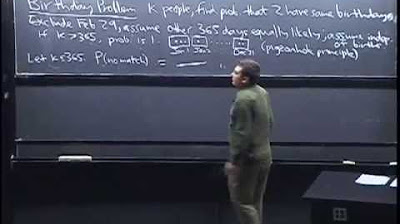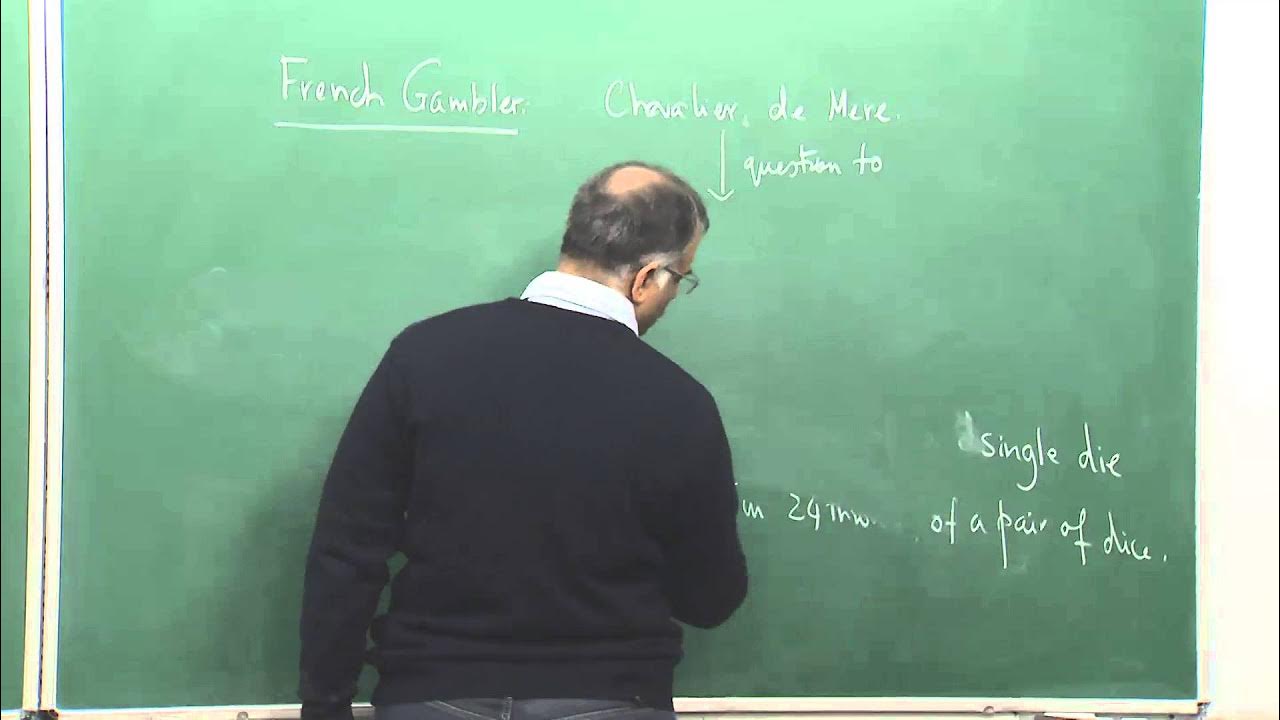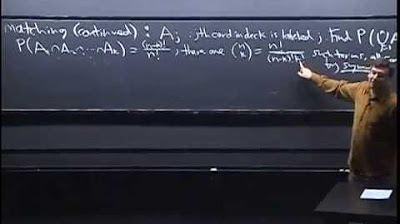Lecture 2: Interesting problems in probablity
TLDRThis lecture delves into the Bertrand Paradox, illustrating the limitations of classical probability definitions by presenting conflicting outcomes for the same scenario. It then explores the foundational problem posed by Chevalier de Mere, which led to the development of probability theory, involving the likelihood of rolling a six with a single die versus a pair of dice. The lecture also introduces Buffon's Needle Problem, which intriguingly links probability to the mathematical constant pi, demonstrating the application of Kolmogorov's axioms in various scenarios, including those with infinite sample spaces.
Takeaways
- 🔍 Bertrand’s paradox demonstrates the inadequacy of the classical definition of probability.
- ⭕ The problem involves a circle with a radius of 2 inches and a concentric inner circle with a radius of 1 inch.
- 📏 The task is to find the probability that a randomly drawn chord intersects the inner circle.
- 📐 A chord intersects the inner circle if its midpoint lies within the inner circle.
- 🔢 The classical method suggests calculating the probability by the ratio of the areas of the inner and outer circles, resulting in a probability of 1/4.
- ♾️ Another approach considers the angle variation of chords, leading to a probability of 1/3.
- 🤔 Bertrand’s paradox reveals that different logical approaches can yield different probabilities for the same problem.
- 🎲 The discussion transitions to the Chevalier de Mere’s gambling problem involving the probability of getting sixes in dice rolls.
- 🧮 Using complementary events and independence, the probabilities for two different dice scenarios are calculated.
- 🪡 Buffon’s needle problem is introduced, relating the probability of a needle intersecting parallel lines to the value of pi.
Q & A
What is Bertrand's paradox and why does it highlight a problem with the classical definition of probability?
-Bertrand's paradox demonstrates the inadequacy of the classical definition of probability by presenting a scenario where two different methods of calculating the probability of the same event yield different results. This shows that the classical definition, which can sometimes be circular, does not always provide a unique solution and thus is not universally applicable.
How does the script describe the first method to solve Bertrand's paradox involving the area of circles?
-The first method described in the script to solve Bertrand's paradox involves considering the probability of a randomly drawn chord intersecting the smaller concentric circle. The solution is found by calculating the ratio of the areas of the two circles, resulting in a probability of 1/4.
What is the second method presented in the script to solve Bertrand's paradox, and what does it yield?
-The second method involves considering the angle variation of the chords drawn from a point on the circumference of the larger circle. By analyzing the maximum angle variation (theta hat) and the total possible angles, the method yields a different probability of 1/3 for the event of a chord intersecting the smaller circle.
Why are the two solutions to Bertrand's paradox considered paradoxical?
-The two solutions are considered paradoxical because they both use logical and seemingly valid methods to arrive at different probabilities for the same event, which contradicts the principle that a probability should be unique and not depend on the method of calculation.
What historical problem related to probability does the script discuss after Bertrand's paradox?
-After discussing Bertrand's paradox, the script discusses a historical problem posed by Chevalier de Mere, which involves determining the probability of rolling a six with a single die thrown four times versus rolling two dice 24 times and getting a double six.
How does the script use the concept of complementary events to solve the problem posed by Chevalier de Mere?
-The script uses the concept of complementary events by first calculating the probability of not rolling a six in a given throw (5/6) and then using the probability of the complementary event (rolling a six) by subtracting the probability of not rolling a six over multiple throws from 1.
What is Buffon's needle problem, and how is it related to the number pi?
-Buffon's needle problem involves determining the probability that a needle of a certain length, thrown at random onto a plane with parallel lines drawn a certain distance apart, will intersect one of the lines. The solution to this problem is related to the number pi because the probability is derived from an integral involving the sine function, resulting in a probability of 1/pi.
How does the script explain the construction of the probability space for Buffon's needle problem?
-The script explains that the probability space for Buffon's needle problem is constructed by considering all possible positions of the needle, represented by the variables theta (the angle the needle makes with the horizontal) and h (the perpendicular distance from the midpoint of the needle to the nearest line). The favorable outcomes are those where h is less than or equal to half of sine theta.
Outlines
🔍 Bertrand's Paradox and Circular Probability Definitions
This paragraph introduces Bertrand's Paradox, which demonstrates the inadequacy of classical circular probability definitions. It explains the paradox through a scenario involving a circle with a concentric circle and the probability of a randomly drawn chord intersecting the inner circle. The paradox is resolved by considering the midpoint of the chord and its position relative to the circles, leading to two different probability calculations based on area ratios and angle variations, resulting in 1/4 and 1/3 probabilities respectively, thus highlighting the paradox's challenge to classical probability definitions.
📚 Revisiting Probability Foundations and Bertrand's Paradox
The script delves deeper into the implications of Bertrand's Paradox, suggesting that traditional probability definitions learned in schools are insufficient. It emphasizes the need for a more robust understanding of probability as a function that maps events to real numbers between 0 and 1, in line with Kolmogorov's axioms. The paradox is further explored by presenting alternative logical interpretations, leading to different yet plausible probability outcomes, thereby providing a comprehensive understanding of the topic.
Mindmap
Keywords
💡Bertrand's Paradox
💡Probability
💡Sample Space
💡Compliment Event
💡Independence
💡Chevalier de Mere
💡Buffon's Needle Problem
💡Kolmogorov Axioms
💡Euclidean Geometry
💡Random Variables
Highlights
Introduction to Bertrand’s paradox, which demonstrates the inadequacy of the classical definition of probability.
Bertrand’s paradox shows two different probabilities for the same problem, highlighting the circular nature of classical probability definitions.
The paradox involves a problem of a randomly drawn chord in a circle and its intersection with an inner circle.
Probability calculation using the area ratio of the inner circle to the outer circle results in 1/4.
An alternative approach to the problem considers the angle variation of possible chords, leading to a different probability of 1/3.
The paradox reveals the need for a more rigorous definition of probability, aligning with Kolmogorov axioms.
Historical context is provided by Chevalier de Mere’s problem involving the probability of rolling a six with a single die versus a pair of dice.
Complimentary events and their probabilities are used to solve de Mere’s problem, demonstrating the concept of independence in events.
The Buffon’s needle problem is introduced, linking probability to the mathematical constant pi.
The problem involves calculating the probability that a randomly thrown needle will intersect a set of parallel lines.
Constructing a probability space for Buffon’s needle problem with infinite outcomes requires careful consideration of the sample space.
The solution to Buffon’s needle problem involves integrating the sine function over a specified range.
The probability of the needle intersecting a line is found to be 1/pi, offering a method to estimate pi through experimentation.
Buffon’s experiment of dropping needles to estimate pi is described, illustrating the practical application of the theoretical problem.
The lecture concludes with a preview of upcoming topics, including random variables, distributions, and the concept of independence.
Transcripts
Browse More Related Video

Calculus Chapter 4 Lecture 42 Fair Probability

Lecture 3: Birthday Problem, Properties of Probability | Statistics 110

Lecture 1: Basic Probability

Lecture 4: Conditional Probability | Statistics 110

Die rolling probability | Probability and combinatorics | Precalculus | Khan Academy

Lecture 12: Buffon's Needle or Pi from Breadsticks
5.0 / 5 (0 votes)
Thanks for rating: